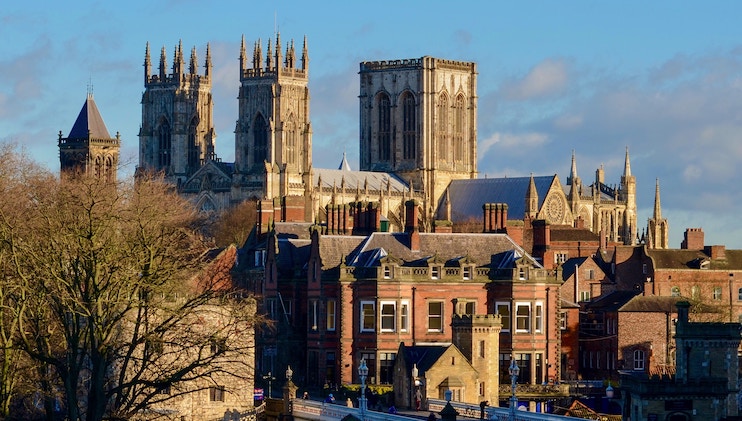Top 5 Historical Buildings in York
Where to get the best of history in this ancient city
By Esther Vincent | Updated Jan 8 2020

York is the go-to destination in the north for visitors with an interest in history. The city has retained lots of its original architecture, and it’s not uncommon to find yourself sipping a drink inside an old chapel or wandering through a pair of classical columns to grab a sandwich at lunch. To get you started, here’s a list of the top architectural attractions to visit in York.
York Minster
Built over the course of 250 years, York Minster caps the city’s horizon at 235ft high. It’s an impressive view from the outside, but be sure to go inside and explore all the hidden spaces inside, or climb the steps of the central tower for an amazing view of York. The iconic Gothic style of the Minster was the result of a commission by Archbishop Walter De Grey, who is also immortalised in the name of York Theatre Royal’s venue, De Grey Rooms. We especially recommend the view of both buildings from just outside York Art Gallery for an ideal photo spot.
York Minster is located at Deangate, York, YO1 7HH.
York Assembly Rooms
This Grade I listed building currently houses an ASK Italian, so you can always stop for some lunch to break up your day of sightseeing. Designed in the eighteenth century by Lord Burlington, York Assembly Rooms was originally used as a venue for upper class social gatherings. ASK has retained some of the luxury of the interior, so you can expect to dine amongst chandeliers and Corinthian columns. The exterior of the building can be spotted by its neoclassical aesthetic - it’s one of the earliest buildings in the North of England to be designed in the Palladian architectural style.
York Assembly Rooms is located at The Grand Assembly Rooms, Blake Street, York YO1 8QG
The Shambles
The Shambles is currently Europe’s most visited street, and it encapsulates York’s quaint, historic atmosphere beautifully. The jumbled timber-frame buildings connect and enclose a tiny cobbled alley, which contains a wealth of hidden finds in terms of street food and gifts. J.K. Rowling notably based Diagon Alley on this very street, and it has retained its fame for this by the introduction of three (immensely popular) Harry Potter themed gift shops. One word of warning is that it’s always crowded, especially since it’s right by Whip-Ma-Whop-Ma-Gate (that’s a real thing, we promise).
The Shambles, York YO1 7LX
Merchant Adventurers Hall
Somewhat bizarrely situated by a row of shops in Piccadilly, this medieval guildhall is a charming building which now functions as a museum, cafe, and occasional wedding venue. Much like the buildings in the Shambles, the timber-framed structure is emblematic of the charm of the city of York. Most of the building was constructed in 1357 by a religious fraternity, which was renamed the Company of the Merchant Adventurers in the sixteenth century. The high status of the Company is representative of the entrepreneurship that helped to make York the city it is today, and currently plays an important role in civic life, including the facilitation of charity events.
Merchant Adventurers Hall can be found at Fossgate, York YO1 9XD
Yorkshire Museum
As well as being an intriguing historical sight, the Yorkshire Museum overlooks the Museum Gardens, a lovely open space perfect for spending a summer’s day in. The Greek revival style building was designed by William Wilkins, and was first established as a museum in 1830. The museum holds four permanent collections, and both the botanical gardens and the River Ouse make a scenic backdrop to the historic area. Notably, the museum is also right next to the Star Inn The City, an atmospheric restaurant overlooking the river.
Yorkshire Museum, Museum Gardens, Museum St, York YO1 7FR